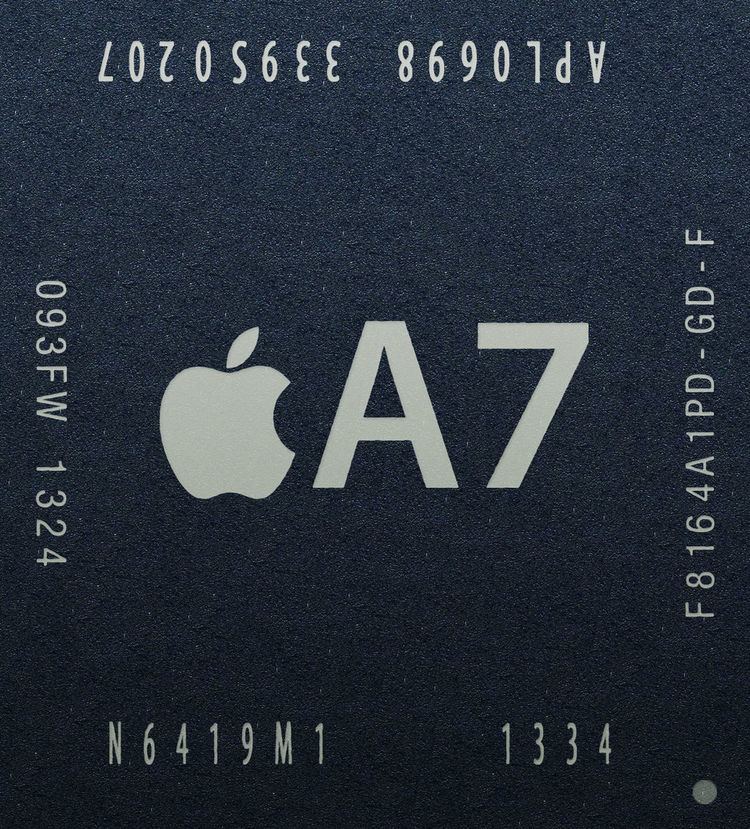Designed by Apple Inc. Max. CPU clock rate 1.3 GHz to 1.4 GHz Instruction set A64, A32, T32 | Min. feature size 28 nm | |
 | ||
Produced From September 20, 2013 to Present | ||
The Apple A7 is a 64-bit system on a chip (SoC) designed by Apple Inc. It first appeared in the iPhone 5S, which was introduced on September 10, 2013. Apple states that it is up to twice as fast and has up to twice the graphics power compared to its predecessor, the Apple A6. While not the first 64-bit ARM CPU, it is the first to ship in a consumer smartphone or tablet computer.
Contents
Design
The A7 features an Apple-designed 64-bit 1.3–1.4 GHz ARMv8-A dual-core CPU, called Cyclone. The ARMv8-A instruction set doubles the number of registers of the A7 compared to the ARMv7 used in A6. It has 31 general purpose registers that are each 64-bits wide and 32 floating-point/NEON registers that are each 128-bits wide.
The A7 also integrates a graphics processing unit (GPU) which AnandTech believes to be a PowerVR G6430 in a four cluster configuration.
The A7 has a per-core L1 cache of 64 KB for data and 64 KB for instructions, a L2 cache of 1 MB shared by both CPU cores, and a 4 MB L3 cache that services the entire SoC.
The A7 includes a new image processor, a feature originally introduced in the A5, used for functionality related to the camera such as image stabilizing, color correction, and light balance. The A7 also includes an area called the "Secure Enclave" that stores and protects the data from the Touch ID fingerprint sensor on the iPhone 5S and iPad mini 3. It has been speculated that the security of the data in the Secure Enclave is enforced by ARM's TrustZone/SecurCore technology. In a change from the Apple A6, the A7 SoC no longer services the accelerometer, gyroscope and compass. In order to reduce power consumption, this functionality has been moved to the new M7 motion coprocessor which appears to be a separate ARM-based microcontroller from NXP Semiconductors.
Apple A7 (APL0698)
Apple uses the APL0698 variant of the A7 chip in the iPhone 5S, iPad Mini 2, and iPad Mini 3. This A7 is manufactured by Samsung on a high-κ metal gate (HKMG) 28 nm process and the chip includes over 1 billion transistors on a die 102 mm2 in size. According to ABI Research the A7 drew 1100 mA during fixed point operations and 520 mA during floating point operations, while its predecessor, the A6 processor in the iPhone 5, drew 485 mA and 320 mA. It is manufactured in a package on package (PoP) together with 1 GB of LPDDR3 DRAM with a 64-bit wide memory interface onto the package.
Apple A7 (APL5698)
Apple uses the APL5698 variant of the A7 chip in the iPad Air. Its die is identical in size and layout to that of the first A7 and is manufactured by Samsung. However, unlike the first version of the A7, the A7 used in the iPad Air is not on a PoP, having no stacked RAM. Instead it uses a chip-on-board mounting, immediately adjacent DRAM, and is covered by a metallic heat spreader, similar to the Apple A5X and A6X.
Patent litigation
The A7's branch predictor has been claimed to infringe on a 1998 patent. On October 14, 2015, a district judge found Apple guilty of infringing U.S. patent US 5781752 , "Table based data speculation circuit for parallel processing computer", on the Apple A7 and A8 processors. The patent is owned by Wisconsin Alumni Research Foundation, a firm affiliated with the University of Wisconsin. The company could be liable for up to US$862.4 million in damages.
Products that include the Apple A7
Gallery
These images are illustrations only.
